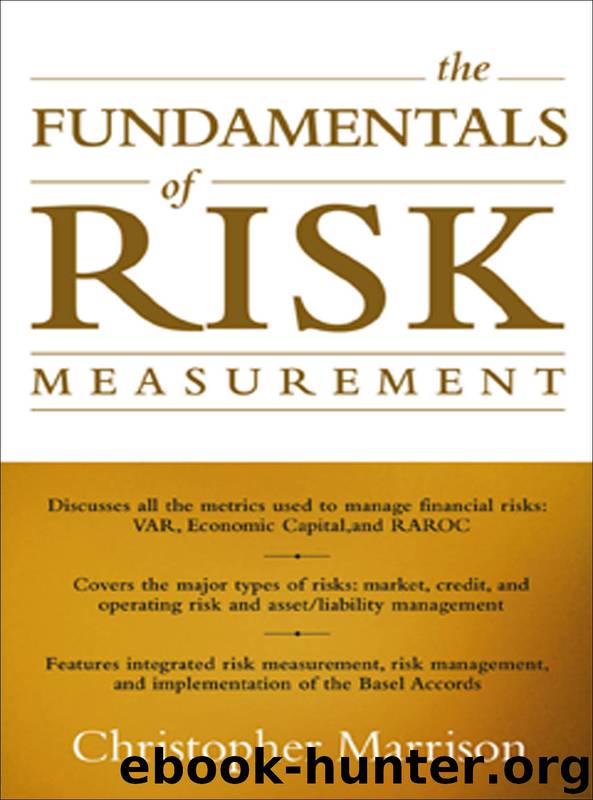The Fundamentals of Risk Measurement by Christopher Marrison

Author:Christopher Marrison
Language: eng
Format: epub
Publisher: McGraw-Hill Education
Published: 2002-03-11T16:00:00+00:00
CHAPTER 15
Funds-Transfer Pricing and the Management of ALM Risks
INTRODUCTION
In the preceding chapters, we examined the ALM interest-rate and liquidity risk to the bank. However, we did not specify which departments within the bank carry that risk. For example, we showed that if the bank has made long-term loans by using money from short-term savings accounts, the bank will suffer a loss if rates rise. However, we did not specify whether that loss should be counted as a loss on the loans, a loss on the savings accounts, or a loss to the fixed-income trading desk. The assignment of this profit and loss is important because it determines the risk and profitability of each business unit and product and therefore the price that the bank should charge its customers.
The way we determine where the risk is located is by using transfer pricing. Transfer pricing is a framework of internal transactions and payments between business units. For ALM purposes, the major units are the lending units, the deposit-taking units, the trading unit, and the ALM desk. The payments between the business units are fictitious in that they are recorded in the accounts for each unit, but no money actually leaves the bank as a whole.
The transfer payments significantly affect the measured accounting profitability of each unit. By affecting the measured profitability, we affect the prices that each unit must charge to its customers, and we affect the bonuses of the staff. If one unit is forced to pay a higher transfer price to another unit, the first unit’s measured profitability will fall, their bonuses will be reduced, and senior management may decide to scale back the activities of the less-profitable unit. For these reasons, transfer pricing can be highly political. Transfer prices, along with capital charges and limits, set the rules within which bankers, traders, and business units must play.
Transfer payments between units are made for one of two reasons: services provided or funds provided. Transfer payments for services is not part of ALM. In this chapter, we are concerned only with funds-transfer pricing, which is also often called the cost of funds (COF). Funds-transfer pricing can be viewed as the interest payments charged when one unit lends funds to another. It is the structure of funds-transfer pricing which moves interest-rate and liquidity risks between units.
In this chapter, we first describe the traditional way of calculating funds-transfer prices and the associated problems of this traditional approach. The bulk of the chapter then discusses matched-funds-transfer pricing, which eliminates most of the problems. In discussing matched-funds-transfer pricing, we first show how it can be used to eliminate or move interest-rate risks, and we give the general rules for transfer pricing. We then discuss the difficulties of transfer pricing for indeterminate maturity products such as checking accounts. Most of the discussion deals with transfer pricing for debt costs, but towards the end we add the complication of transfer pricing for economic capital. Transfer pricing deals with the conceptual movement of funds between accounting entities to measure profit and risk.
Download
This site does not store any files on its server. We only index and link to content provided by other sites. Please contact the content providers to delete copyright contents if any and email us, we'll remove relevant links or contents immediately.
International Integration of the Brazilian Economy by Elias C. Grivoyannis(90918)
The Radium Girls by Kate Moore(11921)
Turbulence by E. J. Noyes(7935)
Nudge - Improving Decisions about Health, Wealth, and Happiness by Thaler Sunstein(7615)
The Black Swan by Nassim Nicholas Taleb(7010)
Rich Dad Poor Dad by Robert T. Kiyosaki(6401)
Pioneering Portfolio Management by David F. Swensen(6226)
Man-made Catastrophes and Risk Information Concealment by Dmitry Chernov & Didier Sornette(5921)
Zero to One by Peter Thiel(5685)
Secrecy World by Jake Bernstein(4644)
Millionaire: The Philanderer, Gambler, and Duelist Who Invented Modern Finance by Janet Gleeson(4374)
The Age of Surveillance Capitalism by Shoshana Zuboff(4209)
Skin in the Game by Nassim Nicholas Taleb(4161)
Bullshit Jobs by David Graeber(4094)
The Money Culture by Michael Lewis(4076)
Skin in the Game: Hidden Asymmetries in Daily Life by Nassim Nicholas Taleb(3929)
The Dhandho Investor by Mohnish Pabrai(3699)
The Wisdom of Finance by Mihir Desai(3651)
Blockchain Basics by Daniel Drescher(3507)
